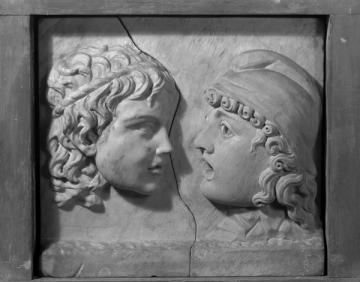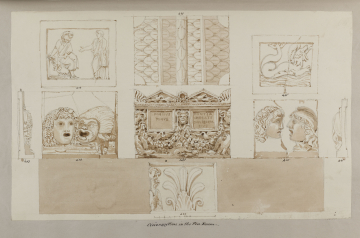Explore Collections


You are here:
CollectionsOnline
/
Roman decorative window panel sculpted on both sides
Browse
Roman decorative window panel sculpted on both sides
117-138 AD
Hadrianic
Hadrianic
Pavonazzetto marble
Height: 28cm
Width: 32.5cm
Thickness: 5cm
Width: 32.5cm
Thickness: 5cm
Museum number: M415
On display: Catacombs
All spaces are in No. 13 Lincoln's Inn Fields unless identified as in No. 12, Soane's first house.
For tours https://www.soane.org/your-visit
Curatorial note
Side A: within a flat frame the head, forepaws, and part of the body of a seadragon swimming amidst the waves, expressed by a series of wavy ridges. The reverse, Side B, depicts on the left, a youthful head with long locks and a cord fillet, facing right, opposed by a (restored) mask-head with long locks beneath a Phrygian cap.
The tail of the seadragon may be completed from a pendant fragment in Budapest1; the reverse of the Budapest half-relief shows that the missing head could be a Triton mask. Hekler dates this and the impressive Budapest no.102 to the second century AD, particularly the Hadrianic period. In addition to the relief panels of this type cited under Soane M413, further examples from Pompeii are exhibited in the Museo Nazionale, Naples2 and there are two of the mask type let into the wall of the Museo Chiaramonti in the Vatican3.
Soane owned two of these carved revolving panels, this one and Soane number M413. Both are framed and mounted on pivots so that they can be turned to view both sides.
1 A. Hekler, Antiker Skulpturen, pp.109-110, no. 101.
2 A. Ruesch, Guida illustrata del Museo Nazionale di Napoli, Naples, 1908, p. 166f., nos. 560-565.
3 W. Amelung, Die Skulpturen des Vaticanischen Museums, Berlin, 1903, Volume I, pp. 511, 515, nos. 299, 303, pl. 54.
The tail of the seadragon may be completed from a pendant fragment in Budapest1; the reverse of the Budapest half-relief shows that the missing head could be a Triton mask. Hekler dates this and the impressive Budapest no.102 to the second century AD, particularly the Hadrianic period. In addition to the relief panels of this type cited under Soane M413, further examples from Pompeii are exhibited in the Museo Nazionale, Naples2 and there are two of the mask type let into the wall of the Museo Chiaramonti in the Vatican3.
Soane owned two of these carved revolving panels, this one and Soane number M413. Both are framed and mounted on pivots so that they can be turned to view both sides.
1 A. Hekler, Antiker Skulpturen, pp.109-110, no. 101.
2 A. Ruesch, Guida illustrata del Museo Nazionale di Napoli, Naples, 1908, p. 166f., nos. 560-565.
3 W. Amelung, Die Skulpturen des Vaticanischen Museums, Berlin, 1903, Volume I, pp. 511, 515, nos. 299, 303, pl. 54.
Unrecorded but presumably acquired with M413; both were in Soane's Museum by 1825 when they appear in views of the newly created 'Urn Room', later known as the Catacombs, and appear in a detailed watercolour of a group of objects from that room.
Soane collections online is being continually updated. If you wish to find out more or if you have any further information about this object please contact us: worksofart@soane.org.uk







